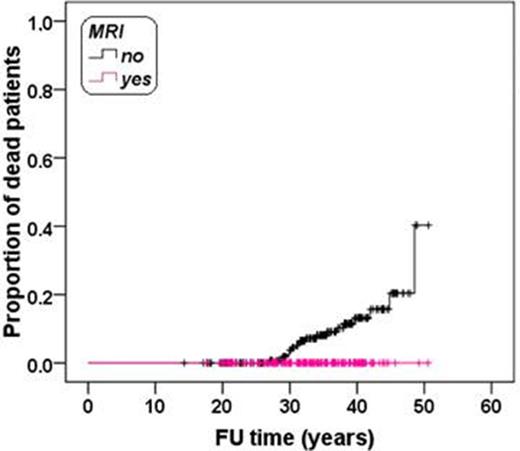Abstract

Background: In 2004 seven Italian centers reported survival data for patients with thalassemia major (TM) and showed that heart disease due to iron overload was the most common cause of death (Borgna et al Haematologica 2004). In the same years the accurate and noninvasive assessment of cardiac siderosis was made possible in Italy by the introduction of the T2* cardiovascular magnetic resonance (CMR).
Purpose: We aimed to evaluate if the deployment of T2* CMR had an impact on the mortality rate.
Methods: Four centers contributed to the present study, updating the data of the enrolled patients until August 31, 2010. For the patients who died, the date of the death represented the end of the study. 577 patients (264 females and 313 males) were included.
Results: One-hundred and fifty-nine (27.6%) patients died, 124 of whom (77.9%) died before the year 2000.
The Table shows the comparison between dead patients and survivors. Dead patients were significantly younger and they were more frequently males. Dead patients started chelation therapy significantly later. HIV, arrhythmias and heart failure were significantly more frequent in dead patients. According to the Cox model, the following variables were identified as significant univariate prognosticators for the death: male sex (HR=1.87, 95%CI=1.34-2.60, P<0.0001), HIV (HR=2.55, 95%CI=1.25-5.20, P=0.010) and heart failure (HR=8.86, 95%CI=6.37-12.31, P<0.0001).
MRI was not performed in 406 patients (70.4%) and no patient had been scanned before his/her death. Among the survivors, MRI was not performed in the 59% of the cases (P<0.0001). The absence of an MRI scan was a significant univariate prognosticator for death (HR=43.25, 95%CI=11.32-165.33, P<0.0001).
The study was restricted to the patients dead after 2004 (19/159=12%) or followed until August 2010 (N=357). In this subgroup of 376 patients, MRI was not performed in the 52.4% of the survivors and in all dead patients (P<0.0001). The absence of a MRI exam was reconfirmed as a strong predictive factor for death (HR=49.37, 95%CI=1.08-2263.24, P=0.046). The Kaplan-Meier curve is showed in Figure 1. The log-rank test revealed a significant difference in the curves (P<0.0001).
Conclusions: Our data suggests that the use of T2* CMR, that enables individually tailored chelation regimes reducing the likelihood of developing decompensated cardiac failure, allowed the reduction of cardiac mortality in chronically transfused TM patients.
Pepe:Novartis: Speakers Bureau; Chiesi: Speakers Bureau; ApoPharma Inc: Speakers Bureau.
Author notes
Asterisk with author names denotes non-ASH members.

This icon denotes a clinically relevant abstract



This feature is available to Subscribers Only
Sign In or Create an Account Close Modal